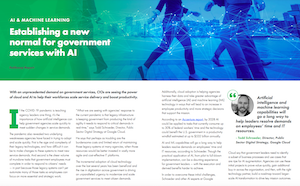- Sponsored
- Modernization
Agencies push to a new normal with the power of artificial intelligence

Artificial intelligence and machine learning are playing a critical role in how government provides public support during the pandemic, pointing to the potential for a new normal of service delivery in government, according to a new report.
As government agencies confront unprecedented demands for services, from unemployment relief to health care support, AI and ML, along with the agility of cloud computing, have become crucial tools in keeping up with scale and scope of demands by the public and on employees’ time.

Read the full report.
These technology-enabled tools are also demonstrating what the future of government looks like, suggests a new report produced by FedScoop and underwritten by Google Cloud.
“Technology is now the core competency of mission delivery, and agencies need to rationalize their portfolios now so that they can stop accumulating technical debt,” says Todd Schroeder, director, public sector digital strategy at Google Cloud.
However, AI implementation remains unfamiliar territory for many government leaders, he says. Having the right partners at the table — with experience developing AI-assisted processes — is an important factor to deliver more meaningful outcomes and long-term benefits to the public, at scale.
It starts with the recognition that AI isn’t so much a technology to buy and deploy. AI’s transformative power lies in how agencies use it to reimagine the mechanics of work.
AI-assisted technology and access to cloud services were instrumental in helping agencies respond to the massive surge in unemployment insurance requestions. A 2020 NASCIO report surveying state CIOs found that roughly three-quarters of U.S. states deployed chatbots to assist with questions on unemployment insurance, general COVID-19 questions or other agency services that are receiving unusually high traffic due to the pandemic.
By implementing turnkey tools like Google’s Contact Center AI, for instance, agencies, like Illinois’ Department of Unemployment, were able to quickly deploy intelligent agents to predict and answer citizen’s most frequent questions.
Being able to take a 30-year old mainframe and adjust it for 120 new questions to satisfy constituents’ most urgent questions can be done at a fraction of the cost of building and maintaining a legacy system, Schroeder says.
Not only do government agencies have thousands of calls and high online traffic demand on their systems, but they’re also drowning in paper, Schroeder says. One of the things that AI and ML allow organizations to do is rapidly process paper documents by pulling data and transmitting that information automatically.
A growing array of cloud-based AI tools are available on a FedRAMP-authorized computing environment, according to the report. These tools — along with Google Cloud’s deep expertise in machine learning — can help agencies streamline how they develop and manage AI components and workflow into their projects, Schroeder says.
Read more about establishing a new normal for government services with AI.
This article was produced by FedScoop and sponsored by Google Cloud.






